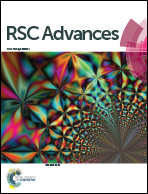Thiacalix[4]arene-supported heterodinuclear NiII–LnIII complexes: slow magnetic relaxation behavior in the dysprosium analogue†
Abstract
Three heterodinuclear complexes, [(NiL1)Ln(L2)(CH3OH)]·acetone (Ln = Gd (1), Tb (2), Dy (3); H3L1 = 1,1,1-tris[(salicylideneamino)methyl]ethane), were stepwise synthesized based on a thiacalix[4]arene ligand (H2L2 = 5,11,17,23-tetrakis(1,1-dimethylethyl)-25,27-dihydroxy-26,28-dimethoxy thiacalix[4]arene). In 1–3, NiII and LnIII ions are doubly bridged by two phenoxo O atoms of L1. The NiII ion, only coordinated by the L1 ligand, features a {NiN3O3} coordination sphere; and the LnIII ion adopts a seven-coordinated {LnO7} environment, capped by one thiacalix[4]arene ligand in a bowl-shaped conformation. Magnetic studies on all complexes reveal that ferromagnetic couplings are operative between the NiII and LnIII ions. The dysprosium analogue (3) exhibits field-induced single-molecule magnet (SMM) behavior under a dc-applied field of 800 Oe. Moreover, the Dy : Y (1 : 10) magnetically diluted sample (3′) shows slow magnetic relaxation at zero dc field. The results demonstrate that the stepwise synthetic method is more useful and effective than self-assembly for designing new 3d–4f heterodinuclear complexes with the thiacalix[4]arene ligand or other derivatives. The introduction of this type of thiacalix[4]arene ligand into the heterodinuclear complexes renders them promising candidates for new SMMs.
![Graphical abstract: Thiacalix[4]arene-supported heterodinuclear NiII–LnIII complexes: slow magnetic relaxation behavior in the dysprosium analogue](/en/Image/Get?imageInfo.ImageType=GA&imageInfo.ImageIdentifier.ManuscriptID=C5RA23697E&imageInfo.ImageIdentifier.Year=2016)

 Please wait while we load your content...
Please wait while we load your content...